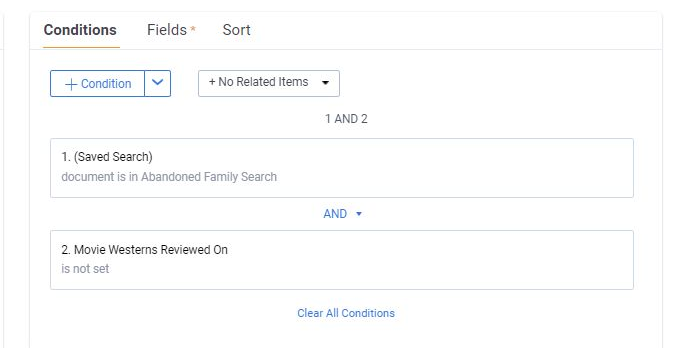May 6, 2023 – Finding Abandoned Families in Active Learning Projects
In an Active Learning project if a reviewer, while in the course of reviewing a family of documents for a prioritized review, is taken off a project, the unreviewed documents from the family may become ‘abandoned’, and will not be fully coded.
When managing an Active Learning project, you should search for any such abandoned family documents for an Active Learning project by running the following searches.
First create a search to find documents that have been reviewed for an Active Learning project and return the results with their family. Look for a field with the name of the Active Learning project and ‘Reviewed On’. In this example the Active Learning project was named, ‘Movie Westerns’. This field contains the date and time at which a document was reviewed.

Second, create another search which includes the results of the first; does not include family documents; and excludes entries for the same field, <Project Name> Reviewed On – use the ‘not set’ option.

May 13, 2023 – Printer Duty Cycles: How Many Pages Can a Printer Print in a Month?
When a litigation team is preparing for a trial, a litigation support professional will often be asked to select the hardware needed for a remote ‘war room’ set up in a hotel or leased office space. The printers you acquire for a trial may not only be put to heavy use for your trial, but they may also have been used to print out large amounts of pages for other firms which leased them previously. When you’re trying to determine whether or not a printer will handle the amount of printing necessary to prepare dozens of witness binders each day for the duration of a trial, look further than just the listed page per minute rate and the paper tray capacity. In the posted specs for a printer, HP or another manufacturer should list the recommended page volume per month and the monthly duty cycle.
The monthly duty cycle is the absolute maximum number of pages that a printer can print out in a one month period.

The recommended monthly page volume is the highest number of pages the manufacturer recommends that you print within a month.

The difference between the duty cycle and the recommended page volume is similar to the difference between the highest possible speed a car can reach and the speed at which it can be regularly driven without causing mechanical problems. A passenger car might be able to reach a speed of 130 mph, but if the same car is driven frequently at 90 mph it soon becomes unreliable.
The recommended monthly page volume will be usually less than 10 per cent of the duty cycle.
May 20, 2023 – Backup Mode for Robocopy
When using robocopy command in Windows to copy files, note that if you are an admin you can use the /B switch to copy files from directories for which you don’t have access. So a command like this:
robocopy C:\foofolder C:\newfolder \B
. . . will bypass the standard rights permissions used in the NFTS file system. This backup mode /B switch will work if a Windows account has SeBackupPrivilege. This is an admin right that allows the copy command to be run without Windows checking to see if the user has rights to copy data to a location.
May 27, 2023 – Paper Weights
The need to print out documents for attorneys, especially when they are working on a trial, will likely never go away entirely. When planning to print out documents to be reviewed in court or used in client presentations it’s important to be conversant in the different types of paper that can be used.
Bond paper is the kind used most frequently in office copies and printers. It is available in different weights – paper is commonly sold at 16, 20, 24, and 46 pounds. The weight of the paper is calculated based on how much 500 sheets will weigh when a given quality of paper is measured uncut at dimensions of 17 inches by 22 inches.
16 pound paper will appear translucent compared to standard office paper and may cause printers to jam.
20 pound paper is the type of bond paper most commonly used in office printers and copiers.
24 pound paper is an upgrade available for bond paper and may be used in order to prevent bleed through on double-sided print-outs. Letterhead is commonly printed on 24 pound bond paper.
46 pound paper is the type of bond paper commonly used for brochures or menus.
Heavier paper between 50 to 100 pounds is referred to as text paper and is used in commercial printing for greeting cards. Index paper is the type of paper index cards are made from, and can exceed 100 pounds. Business cards may be printed on 80 pound paper. Tab dividers and manila folders are commonly at 110 pound index paper.
When selecting the best paper to use with a printer look for multipurpose paper or premium color paper. Multipurpose paper is smoother than standard bond copy paper and it has a more uniform surface. Premium color paper, or laser paper, is an upgrade over multipurpose paper and includes a thin coating – while not having the heavy coating used for photo paper. Using multipurpose or premium laser paper may make a high-end copier or printer less likely to jam.


